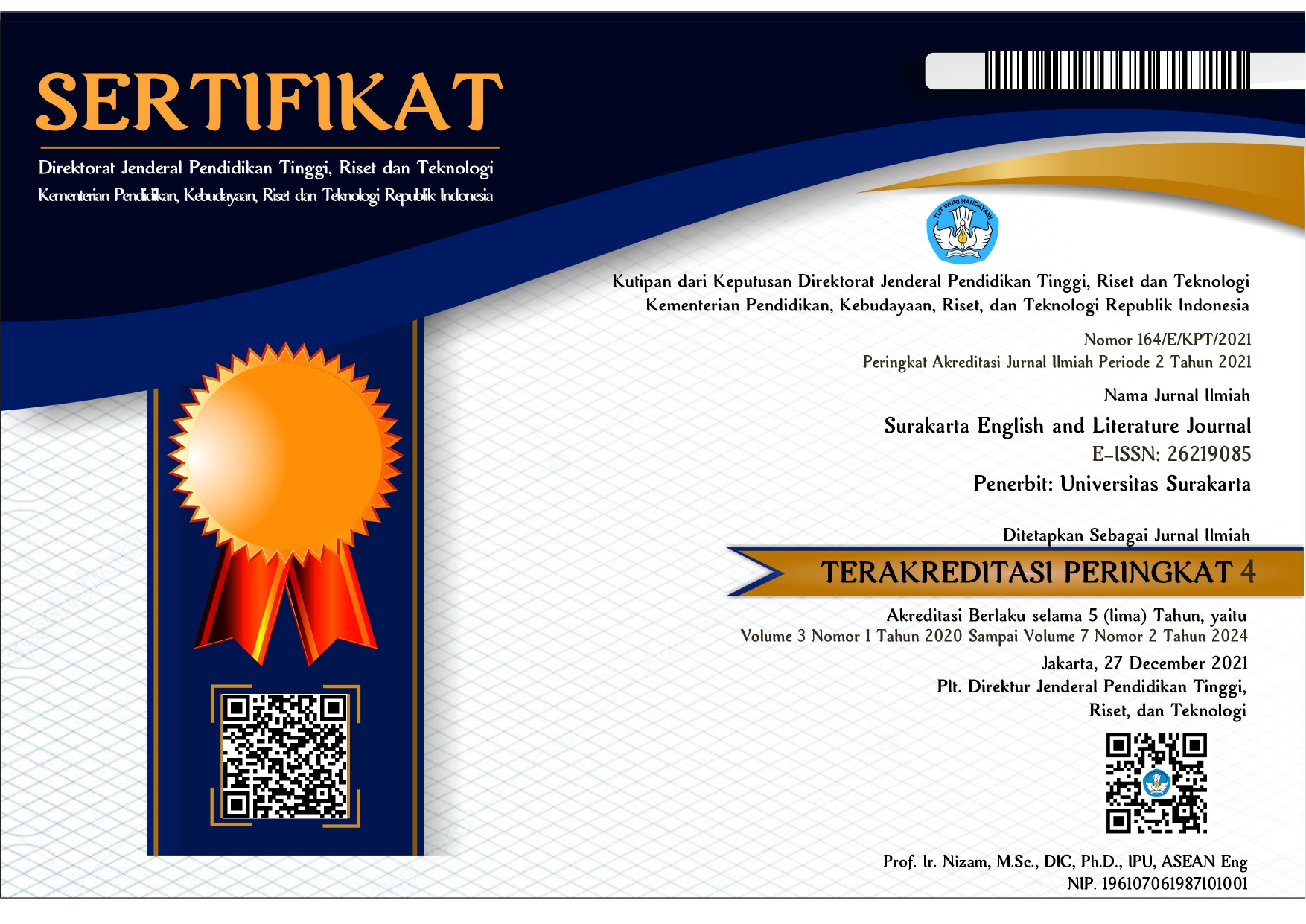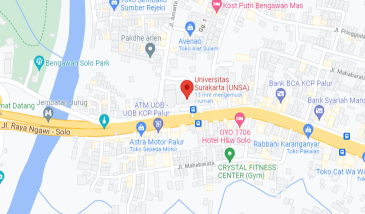EFL Students’ Critical Thinking and Their Reading Comprehension Ability: A Study Case Of Students In SMP Negeri 2 Baubau
DOI:
https://doi.org/10.52429/selju.v6i2.110Keywords:
EFL Students’, Critical Thinking, Comprehension of Reading, AbilityAbstract
The purpose of this study was to determine whether there was a relationship between students' critical thinking skills and their capacity for reading comprehension. This study employed the ex-post facto research design as a quantitative approach, and the population of this study consisted of 345 eighth graders from SMP Negeri 2 Baubau, the sample consisted of 50 EFL students from the overall population, which was drawn using a straightforward random sampling procedure, tests and questionnaires served as the research's instruments. The findings of the investigation can be concluded that there was a strong relationship between the capacity of EFL students to think critically and their comprehension of reading. It is suggested that EFL students develop their critical thinking skills because they are necessary for reading comprehension as well as other language skills in language learning.
References
Aloqaili, A. S. (2012). The relationship between reading comprehension and critical thinking: A theoretical study. Journal of King Saud University-Languages and Translation, 24(1), 35–41.
Baier, R. J. (2005). Reading Comprehension and Reading Strategy.
Creswell, J. W. (2012). Educational Research: Planning, conducting, and evaluating quantitative and qualitative research Pearson Education. Inc.
Davenport, T. R. (2007). Mastering the SAT critical reading test. Cliffs Notes.
Day, R. R., & Park, J. (2005). Developing Reading Comprehension Questions. Reading in a Foreign Language, 17(1), 60–73.
G. Bassham. (2011). Critical thinking: A student’s introduction.
G. Meo. (2008). Curriculum planning for all learners: Applying universal design for learning (UDL) to a high school reading comprehension program. Prev. Sch. Fail. Altern. Educ. Child. Youth, 52(2), 21–30.
Grabe, W. P., & Stoller, F. L. (2013). Teaching and researching: Reading. Routledge.
Hidayati, M., Inderawati, R., & Loeneto, B. (2020). The correlations among critical thinking skills, critical reading skills, and reading comprehension. ENGLISH REVIEW: Journal of English Education, 9(1), 69–80.
Indonesia, R. (2014). Permendikbud No. 104 Tahun 2014 tentang Penilaian Hasil Belajar oleh Pendidik pada Pendidikan Dasar dan Pendidikan Menengah. Jakarta: Kemendikbud.
Lenz, K. (2005). An introduction to reading comprehension. Available Website: Http://Www. Specialconnections. Ku. Edu.
Nurgiyantoro, B., Gunawan, M., & Marzuki, D. M. (2015). Statistik terapan untuk penelitian ilmu sosial. Gadjah Mada University.
Octaviani, S. K., & Sari, A. (2022). Application of Microsoft Office 365 as English Vocabulary Learning Media for Vocational High School Students. Surakarta English and Literature Journal, 5(1), 1–12.
Paul, R. (2004). The state of critical thinking today: The need for a substantive concept of critical thinking. Retrieved July 15, 2009.
Pratiwi, A. (2018). The correlation between students’ critical thinking and vocabulary mastery at SMAN 3 Palangka Raya. IAIN Palangka Raya.
Riduwan, M. B. A. (2004). Metode & teknik menyusun tesis. Alfabeta, Bandung.
Riduwan, S. (2011). Pengantar Statistika untuk penelitian pendidikan, sosial, ekonomi, komunikasi dan bisnis. Cetakan Ke-4 Bandung: Alfabeta.
Sarigoz, O. (2012). Assessment of the high school students’ critical thinking skills. Procedia-Social and Behavioral Sciences, 46, 5315–5319.
Sugiyono. (2013). Metode Penelitian Pendidikan Pendekatan Kuantitatif, Kualitatif, dan R&D. Alfabeta.
Tarihoran, N., & Rachmat, M. (2019). Reading 1 Basic Reading Skills.
Wijayanti, E., Sutarsyah, C., & Huzairin, H. (2014). The Correlation Between Students’ Critical Thinking and Their Reading Comprehension Ability. Lampung University.
Wijayanti, E., Sutarsyah, C., & Huzairin, H. (2015). The Correlation Between Students’ Critical Thinking and Their Reading Comprehension Ability. Lampung University.
Wulandari, R. (2018). The relationship between critical thinking and reading comprehension by the second-year students of State Islamic Senior High School 4 Kampar. Universitas Islam Negeri Sultan Syarif Kasim Riau.
Aloqaili, A. S. (2012). The relationship between reading comprehension and critical thinking: A theoretical study. Journal of King Saud University-Languages and Translation, 24(1), 35–41.
Baier, R. J. (2005). Reading Comprehension and Reading Strategy.
Creswell, J. W. (2012). Educational Research: Planning, conducting, and evaluating quantitative and qualitative research Pearson Education. Inc.
Davenport, T. R. (2007). Mastering the SAT critical reading test. Cliffs Notes.
Day, R. R., & Park, J. (2005). Developing Reading Comprehension Questions. Reading in a Foreign Language, 17(1), 60–73.
G. Bassham. (2011). Critical thinking: A student’s introduction.
G. Meo. (2008). Curriculum planning for all learners: Applying universal design for learning (UDL) to a high school reading comprehension program. Prev. Sch. Fail. Altern. Educ. Child. Youth, 52(2), 21–30.
Grabe, W. P., & Stoller, F. L. (2013). Teaching and researching: Reading. Routledge.
Hidayati, M., Inderawati, R., & Loeneto, B. (2020). The correlations among critical thinking skills, critical reading skills, and reading comprehension. ENGLISH REVIEW: Journal of English Education, 9(1), 69–80.
Indonesia, R. (2014). Permendikbud No. 104 Tahun 2014 tentang Penilaian Hasil Belajar oleh Pendidik pada Pendidikan Dasar dan Pendidikan Menengah. Jakarta: Kemendikbud.
Lenz, K. (2005). An introduction to reading comprehension. Available Website: Http://Www. Specialconnections. Ku. Edu.
Nurgiyantoro, B., Gunawan, M., & Marzuki, D. M. (2015). Statistik terapan untuk penelitian ilmu sosial. Gadjah Mada University.
Octaviani, S. K., & Sari, A. (2022). Application of Microsoft Office 365 as English Vocabulary Learning Media for Vocational High School Students. Surakarta English and Literature Journal, 5(1), 1–12.
Paul, R. (2004). The state of critical thinking today: The need for a substantive concept of critical thinking. Retrieved July 15, 2009.
Pratiwi, A. (2018). The correlation between students’ critical thinking and vocabulary mastery at SMAN 3 Palangka Raya. IAIN Palangka Raya.
Riduwan, M. B. A. (2004). Metode & teknik menyusun tesis. Alfabeta, Bandung.
Riduwan, S. (2011). Pengantar Statistika untuk penelitian pendidikan, sosial, ekonomi, komunikasi dan bisnis. Cetakan Ke-4 Bandung: Alfabeta.
Sarigoz, O. (2012). Assessment of the high school students’ critical thinking skills. Procedia-Social and Behavioral Sciences, 46, 5315–5319.
Sugiyono. (2013). Metode Penelitian Pendidikan Pendekatan Kuantitatif, Kualitatif, dan R&D. Alfabeta.
Tarihoran, N., & Rachmat, M. (2019). Reading 1 Basic Reading Skills.
Wijayanti, E., Sutarsyah, C., & Huzairin, H. (2014). The Correlation Between Students’ Critical Thinking and Their Reading Comprehension Ability. Lampung University.
Wijayanti, E., Sutarsyah, C., & Huzairin, H. (2015). The Correlation Between Students’ Critical Thinking and Their Reading Comprehension Ability. Lampung University.
Downloads
Published
How to Cite
Issue
Section
License
Copyright (c) 2023 Baharudin Adu

This work is licensed under a Creative Commons Attribution-ShareAlike 4.0 International License.
Licensing for Data Publication
-
Open Data Commons Attribution License, http://www.opendatacommons.org/licenses/by/1.0/ (default)
-
Creative Commons CC-Zero Waiver, http://creativecommons.org/publicdomain/zero/1.0/
-
Open Data Commons Public Domain Dedication and Licence, http://www.opendatacommons.org/licenses/pddl/1-0/














